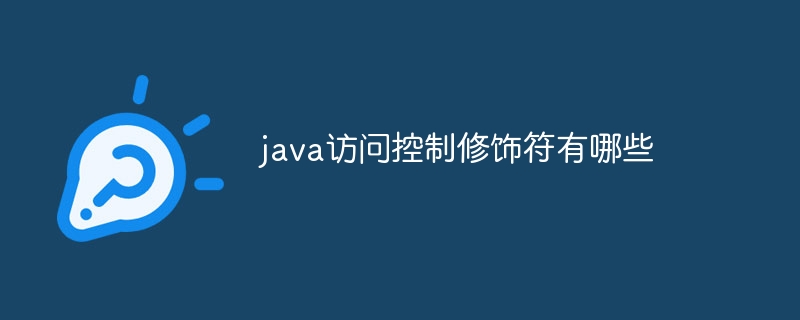What are the java access control modifiers?
There are four types of java access control modifiers, namely public, protected, private, and default access modifiers. Detailed introduction: 1. Public, public is the loosest access control modifier. Modified classes, methods and variables can be accessed by any other class. When a class, method or variable is declared as public, they can be accessed anywhere be accessed, whether it is a class in the same package or a class in a different package; 2. protected modifier, etc.

Java is an object-oriented programming language with rich access control modifiers for controlling access to classes, methods, and variables. In Java, there are four access control modifiers, namely public, protected, private and default access modifiers.
1. public: public is the loosest access control modifier. Modified classes, methods and variables can be accessed by any other class. When a class, method or variable is declared public, they can be accessed from anywhere, whether it is a class in the same package or a class in a different package. For example:
java
public class MyClass {
public void myMethod() {
// 公共方法
}
}2. protected: The access permission of the protected modifier is between public and private. Classes, methods and variables modified by protected can be accessed by other classes in the same package, or by subclasses in different packages. However, non-subclasses in different packages cannot access protected members. For example:
java
protected class MyClass {
protected void myMethod() {
// 受保护的方法
}
}3. private: private is the strictest access control modifier. Classes, methods and variables modified by private can only be accessed in the same class. Other classes cannot directly access members modified by private. For example:
java
public class MyClass {
private int myVariable;
private void myMethod() {
// 私有方法
}
}4. Default access modifier: When no access control modifier is used, the default access permission is package-level access permission. Classes, methods, and variables modified by the default access modifier can be accessed by other classes in the same package, but classes in different packages cannot. For example:
java
class MyClass {
void myMethod() {
// 默认访问方法
}
}To summarize, the access control modifiers in Java include public, protected, private and default access modifiers. Understanding the usage rules and access permissions of these modifiers can help developers better control the access permissions of classes, methods, and variables, and improve the security and maintainability of the code.
The above is the detailed content of What are the java access control modifiers?. For more information, please follow other related articles on the PHP Chinese website!

Hot AI Tools

Undresser.AI Undress
AI-powered app for creating realistic nude photos

AI Clothes Remover
Online AI tool for removing clothes from photos.

Undress AI Tool
Undress images for free

Clothoff.io
AI clothes remover

AI Hentai Generator
Generate AI Hentai for free.

Hot Article

Hot Tools

Notepad++7.3.1
Easy-to-use and free code editor

SublimeText3 Chinese version
Chinese version, very easy to use

Zend Studio 13.0.1
Powerful PHP integrated development environment

Dreamweaver CS6
Visual web development tools

SublimeText3 Mac version
God-level code editing software (SublimeText3)

Hot Topics
 Square Root in Java
Aug 30, 2024 pm 04:26 PM
Square Root in Java
Aug 30, 2024 pm 04:26 PM
Guide to Square Root in Java. Here we discuss how Square Root works in Java with example and its code implementation respectively.
 Perfect Number in Java
Aug 30, 2024 pm 04:28 PM
Perfect Number in Java
Aug 30, 2024 pm 04:28 PM
Guide to Perfect Number in Java. Here we discuss the Definition, How to check Perfect number in Java?, examples with code implementation.
 Random Number Generator in Java
Aug 30, 2024 pm 04:27 PM
Random Number Generator in Java
Aug 30, 2024 pm 04:27 PM
Guide to Random Number Generator in Java. Here we discuss Functions in Java with examples and two different Generators with ther examples.
 Armstrong Number in Java
Aug 30, 2024 pm 04:26 PM
Armstrong Number in Java
Aug 30, 2024 pm 04:26 PM
Guide to the Armstrong Number in Java. Here we discuss an introduction to Armstrong's number in java along with some of the code.
 Weka in Java
Aug 30, 2024 pm 04:28 PM
Weka in Java
Aug 30, 2024 pm 04:28 PM
Guide to Weka in Java. Here we discuss the Introduction, how to use weka java, the type of platform, and advantages with examples.
 Smith Number in Java
Aug 30, 2024 pm 04:28 PM
Smith Number in Java
Aug 30, 2024 pm 04:28 PM
Guide to Smith Number in Java. Here we discuss the Definition, How to check smith number in Java? example with code implementation.
 Java Spring Interview Questions
Aug 30, 2024 pm 04:29 PM
Java Spring Interview Questions
Aug 30, 2024 pm 04:29 PM
In this article, we have kept the most asked Java Spring Interview Questions with their detailed answers. So that you can crack the interview.
 Break or return from Java 8 stream forEach?
Feb 07, 2025 pm 12:09 PM
Break or return from Java 8 stream forEach?
Feb 07, 2025 pm 12:09 PM
Java 8 introduces the Stream API, providing a powerful and expressive way to process data collections. However, a common question when using Stream is: How to break or return from a forEach operation? Traditional loops allow for early interruption or return, but Stream's forEach method does not directly support this method. This article will explain the reasons and explore alternative methods for implementing premature termination in Stream processing systems. Further reading: Java Stream API improvements Understand Stream forEach The forEach method is a terminal operation that performs one operation on each element in the Stream. Its design intention is





